

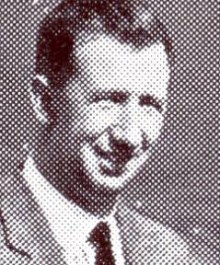
A detail from the previous photo showing Shute looking very young with nice chubby cheeks. (Photo: FM / SR ) |
1933:In a conversation with Arnold G. Wilson at the Yorkshire Aero Club, Shute suggests designing an aeroplane in which the pilot sits above and behind the machine. The theory was that this would make landing easier because of the pilot's improved perspective. Tiltman designs the AS 31. It was never built. Shute later uses the idea of the pilot's view of the machine from above and behind in In The Wet. |
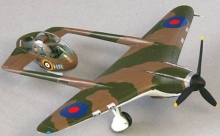
This is a model of the proposed but never built Airspeed AS31. The model is available through Unicraft Models. Click for larger image |
September 1933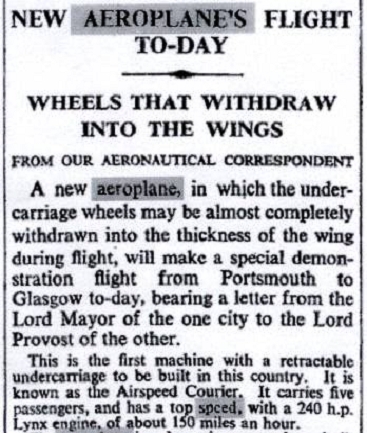
First Courier is delivered to dealers. The last Courier, GACVF, flew in 1947. The Courier is reported in The Times of September 18, 1933 Click here to see a Player's Cigarette Card depicting a Courier in flight. |
1933The Shute Family move to a house called "Landfall" near the village of Bishops Waltham between Fareham and Winchester in Hampshire. Bishops Waltham dates from before 720AD. |
Click for larger image
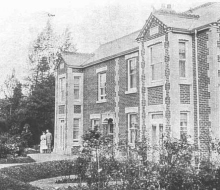
This house, originally called Northleigh when it was built in 1904 was divided about 1954 into 2 houses. One half was then called Landfall. It is believed that the Shute family may have lived here in 1933 and the Landfall half was later named in Shute's honour. The couple in the photo are probably the original owners. ( DDT ) |
1933 - 1939Shute writes In the Uttermost Parts of The Sea about a sea rescue by an aircraft carrier. It is set in 1932. |
December 12th 1933Shute is elected a Fellow of the Royal Aeronautical Society (FRAeS) for his work on retractable undercarriage. This experience is reflected in No Highway. |
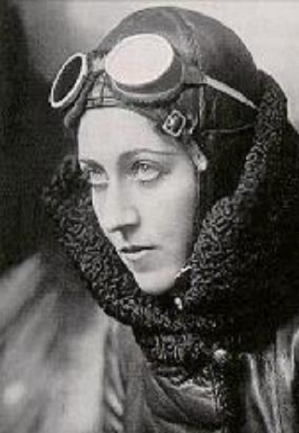
|
Amy Johnson. (1903 - 1941)
|
1934World Economic Depression lessens. Shute's short story Air Circus is published in Blackwoods Magazine. |
|
|
Built for The Air Ministry, Airspeed Courier K4047 stands ready for a test flight in February 1934. (Photo: FM / DHM / DH ) |
 Click for larger image
Click for larger image |
July 1934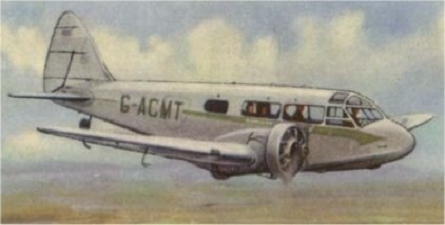 |
The Twin Engined Airspeed Envoy is completed and shown at the SBAC display. Click here to see a Player's Cigarette Card depicting an AS Envoy in flight See more information about the Airspeed Envoy in service to the Crown during WWII |
|
This is the stylish Interior of an AS6 Envoy. Note the high quality of the interior finish with what I am certain is red leather piping on the seats. The smart clothes and the chic 1930s haircut of the very pretty woman on the right suggest that this is a posed publicity shot. Barry Stobart Hook believes that the picture of "the very pretty woman" sitting on the right in the interior of this photo is his mother. A publicity shot of the same lady, who was working as a secretary for Airspeed at the time, can be seen here.
Photo BSH |
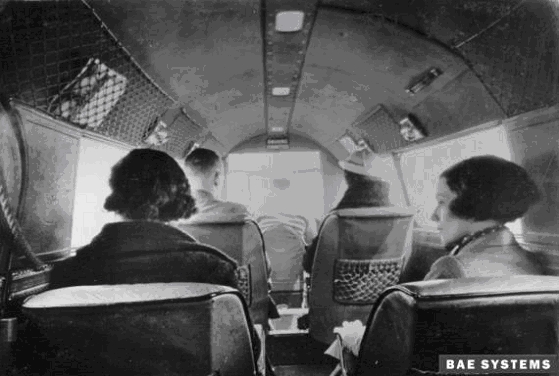
|
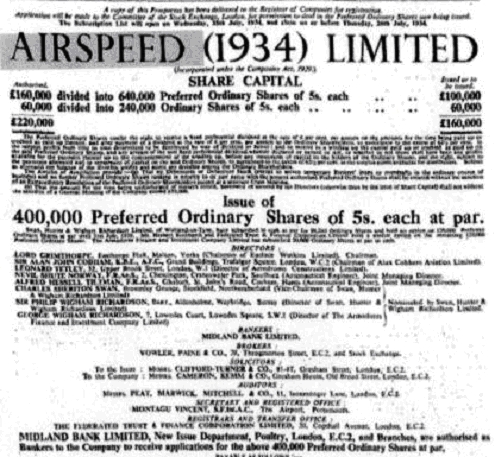
|
This ad in The Times of July 24 1934 advertised the 1934 Airspeed share offer for which Shute risked his reputation by valuing Airspeed's, increasingly obsolescent, unsold aircraft at their full retail price. The subsequent demand for aircraft for the Spanish Civil War proved him right. |
|
Forester Lindsley (1915 - 2006), aged 19, at Airspeed in 1934. At 16, Forester joined Airspeed in York and moved with it to Portsmouth. Forester worked on Cobham's Air Circus planes and was a ground engineer on the first Ferry flights and was also involved in the aerial refuelling project. He met Amy Johnson several times and also said that he knew Flt Lt Colman, Airspeed's test pilot, well. Forester spoke admiringly of Shute and Tiltman. (Photo: Courtesy of Nick Lindsley 2006) |
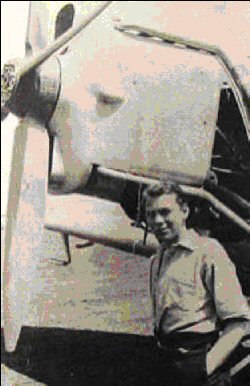
|
Middle 1934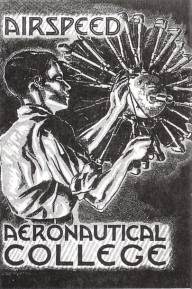 |
In Mid 1934 Shute starts the Airspeed Aeronautical College. This prospectus cover was drawn by Concord and Cavendish Morton. ( DHM ) |
This is an illustration of the Airspeed Courier's retractable undercarriage from the Airspeed Aeronautical College Prospectus. DHM |
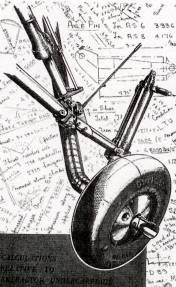
|
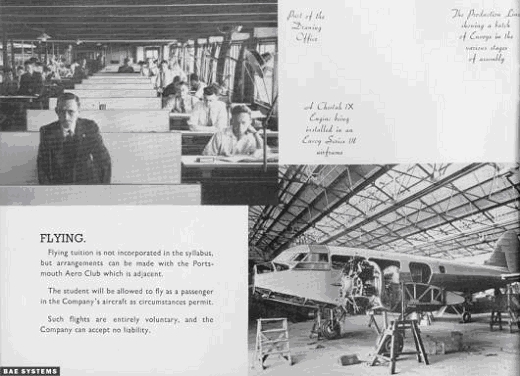
The Airspeed drawing office and an Airspeed Envoy in the spacious, modern and well-lit Portsmouth factory are shown in part of the Airspeed Aeronautical Academy brochure. (Copyright © BAE SYSTEMS PLC) |
Autumn 1934The DC2 appears in Europe signalling a quantum leap in aircraft design. |
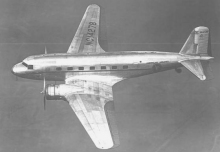 Click for larger image
Click for larger image
|
The Douglas DC-2 was the immediate forerunner of the perfected and soon famous DC-3 that appeared in late 1935. Like the DC-3, The DC-2 was an all-metal monoplane with tapered wings, retractable landing gear and variable pitch propellers, it carried 14 passengers. (PP) |
|
This article from The Times of September 24 1934 tells how Alan Cobham's National Aviation Day Handley Page tanker plane crashed after refuelling Alan Cobham's Airspeed Courier for his attempt to fly non-stop to India. At least 2 aeroplanes, a Courier and this Handley Page, crashed in connection with aerial refueling research work. |
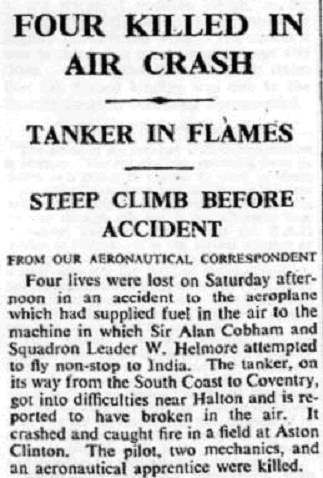
|
 Click for larger image
Click for larger image |
The interior of the Portsmouth factory in late 1934 showing Airspeed Envoy G-ACVI. Fitted with Wolseley Aries engines it built for Lord Nuffield and won the 1934 London to Johannesburg Air Race. It was registered on October 10, 1934 and named "Miss Wolseley". Behind it is the Air Ministry's Courier K-4047. ( DHM / DH ) |